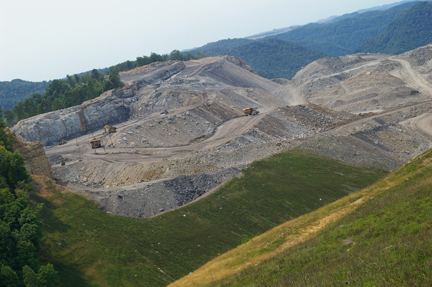((mtr_include))
This week, Gabriel Pacyniak and Katherine Chandler are traveling throughout southern West Virginia to report on mountaintop removal mining (MTR). They’ll be visiting coalfields with abandoned and "reclaimed" MTR mines, and talking with residents, activists, miners, mine company officials, local reporters, and politicians.
We’ll publish their reports throughout the week.
—–
At the Cabin Creek Rd. exit along Interstate 64, we turn off onto a two-lane drive that follows the creek. We pass from one hollow to another, small communities of West Virginians in the cramped valleys of Appalachia. At the end of the road, atop Kayford Mountain, lives Larry Gibson,  the unofficial ambassador of the movement to stop mountaintop removal mining, or MTR. Gibson has been fighting MTR for 22 years, and has over 5,000 visitors signed into his guest book. This includes CNN’s Anderson Cooper, who showcased Gibson last week on his 360 Heroes program. It is our first stop on a five-day trip across the coalfields of southern West Virginia, looking at how MTR has changed the landscape 30 years after the passage of the federal Surface Mining Reclamation and Control Act.
the unofficial ambassador of the movement to stop mountaintop removal mining, or MTR. Gibson has been fighting MTR for 22 years, and has over 5,000 visitors signed into his guest book. This includes CNN’s Anderson Cooper, who showcased Gibson last week on his 360 Heroes program. It is our first stop on a five-day trip across the coalfields of southern West Virginia, looking at how MTR has changed the landscape 30 years after the passage of the federal Surface Mining Reclamation and Control Act.
From the highway, it is difficult to imagine the devastation that has occurred at the mine site; the green, rolling hills seem to stretch out forever, hidden in the light haze of summer. As we continue up the road, we pass by the houses of local residents and a few community churches, following the dirt fork to the right that takes us over a small bridge. There’s still no visible sign of the strip mining taking place all around us, but we do see our first sign of mining’s impact — the one-lane dirt road bridge has been reinforced to hold a 40,000-pound truck.

The blasting area at Kayford Mountain. (photo: Katherine Chandler)
On the way up we pass the entrance to the Massey Energy strip mine. A giant pile of gravel blocks the view, leaving us unprepared for the scene that Gibson shows us at the edge of his property, where his family has lived for years. Here, the landscape has been completely transformed, the lush green replaced with gray piles of rubble and small patches of the valuable coal veins that run from here to Kentucky. A dragline scoops giant rock and debris blasted earlier in the day into three massive 190-ton loaders. Gibson points out that the whole operation only requires a handful of laborers, while the deep mines that operated in the area employed hundreds.
Afterwards, Gibson brings us to his pavilion to show us how the mountain has been torn apart, using a hand-built wooden model. The contours of the original mountain are hundreds of feet taller than they are today, actually towering above the high ridge that we had looked upon the mine from earlier. Millions of tons of unwanted rock have been pushed over the edge to bury valleys and streams, showing the impact of these operations on not only the mountaintops but also the valleys beneath them. He also shows us a picture of a pickup-sized rock sitting on the road, explaining that it is flyrock, literally an errant boulder blasted hundreds of feet outside the mine.

The view from the top of Kayford Mountain. (photo: Katherine Chandler)
Towards the end, an emotional Gibson recounts how a dozer ran through his family’s historic cemetery in the past month. "You have to get the fire in your belly!," he implores us.
Our next stop will be at the Charleston, W.Va., airport, where Tom White, a volunteer pilot with non-profit organization Southwings will show us the scope of MTR from the air.
 the unofficial ambassador of the movement to stop
the unofficial ambassador of the movement to stop 


